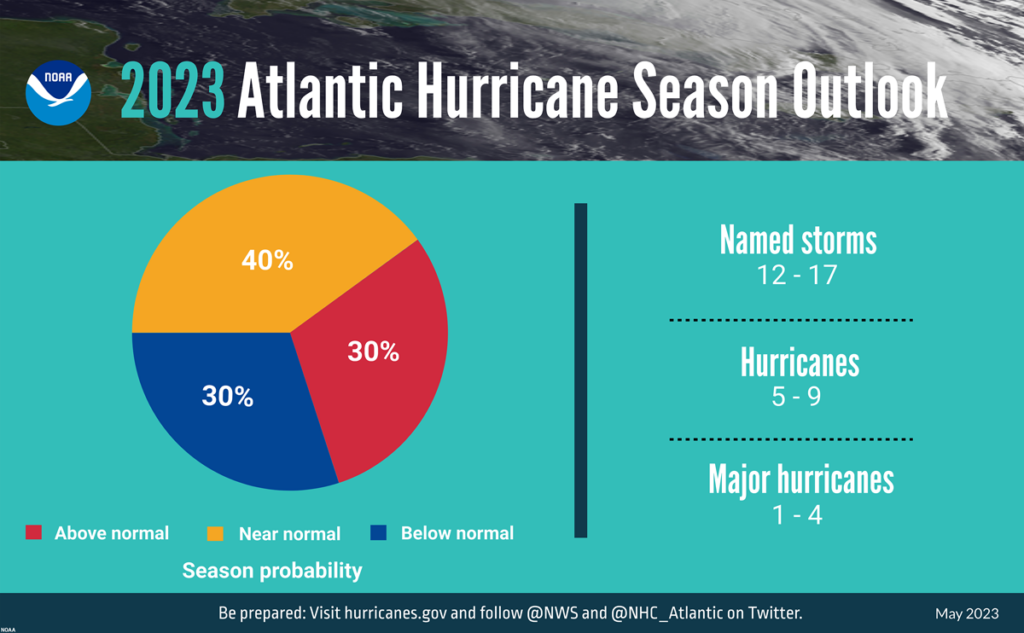This year marks the first season in 7 years without a predicted above-average Atlantic hurricane season, according to NOAA’s 2023 hurricane outlook, released today. But that’s not the only unusual part about it.
Storm-dampening effects from a burgeoning El Niño are butting heads with storm-boosting effects from warm Atlantic waters.
“It’s definitely kind of a rare setup for this year.”
“It’s definitely kind of a rare setup for this year,” said lead NOAA hurricane season forecaster Matthew Rosencrans.
The Climate Prediction Center in NOAA’s National Weather Service issues the forecast each spring in the days leading up to the start of hurricane season, which runs from 1 June to 30 November.
With 70% confidence, the agency predicted a range of between 12 and 17 named tropical storms this year. Five to nine of the named storms could become hurricanes, with one to four classified as major hurricanes.
Named storms have wind speeds above 39 miles per hour (63 kilometers per hour), hurricane wind speeds are more than 74 miles per hour (119 kilometers per hour), and those of major hurricanes are more than 111 miles per hour (179 kilometers per hour).
The outlook is based on the agency’s climate models and evaluations of large-scale climate features. The forecast does not predict whether storms will make landfall.
“Remember, it only takes one storm to devastate a community,” said NOAA administrator Rick Spinrad at a news conference.

NOAA’s outlook falls largely within the predictions of hurricane outlooks released earlier this year by other scientific agencies, hurricane science teams, and government meteorological organizations.
Conflicting Effects
Competing forces in the Atlantic are warring to push the season into either above-normal or below-normal territories. “It’s kind of like a clash,” Rosencrans said.
El Niño has a 90% chance of developing this year, according to the Climate Prediction Center’s 11 May outlook. El Niño is the warm phase of the El Niño–Southern Oscillation, and it typically subdues hurricane activity in the Atlantic.
El Niño interferes with Atlantic storm formation by boosting high-altitude westerly winds and strengthening lower-altitude easterly winds, intensifying vertical wind shear. The tops of storms can be blown off center by strong vertical winds, stretching and unwinding them. It also brings dry, sinking air to the Atlantic Ocean and stabilizes the atmosphere. Together, these features dampen storm activity.
Warm pockets of water in the Atlantic could fuel and energize atmospheric disturbances into storms.
On the other hand, unusually warm Atlantic Ocean waters have developed in the Caribbean and near West Africa. The season’s above-normal West African monsoon will create atmospheric waves that travel east and instigate Atlantic storms. Warm pockets of water in the Atlantic could fuel and energize atmospheric disturbances into storms.
The Atlantic has been in a high-activity hurricane era since 1995, likely caused by the slow-changing climate phase called the Atlantic Multidecadal Oscillation.
Together, the warm ocean temperatures, above-average West African monsoon, and ramped-up activity are working against the suppressing action of the developing El Niño.
For this reason, forecasters are entering the season more uncertain than in recent years.
Last year, hurricane season began quietly in the Atlantic, with only three named storms developing by August. But in September, the season became one of the most deadly and damaging in modern history, according to NPR.
In 2020 and 2021, the hurricane seasons grew so busy that forecasters ran out of storm names.
“It’s absolutely crucial that all Americans living in potential paths of these storms, even well inland of the coasts, follow NOAA’s guidance for the preparation and determine your risk,” Spinrad said.
—Jenessa Duncombe (@jrdscience), Staff Writer

